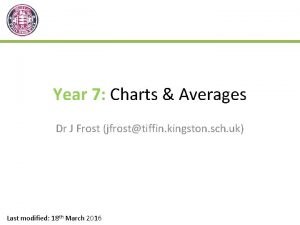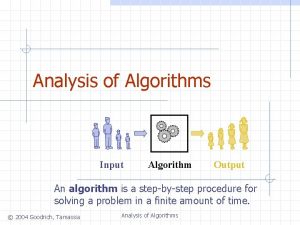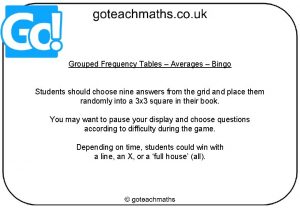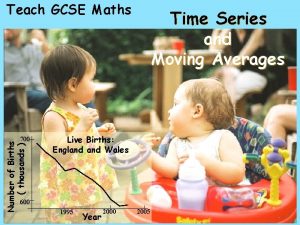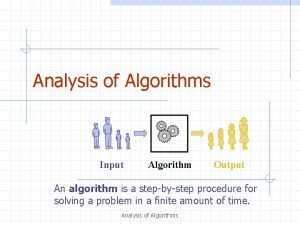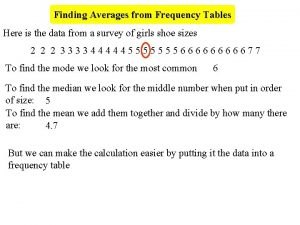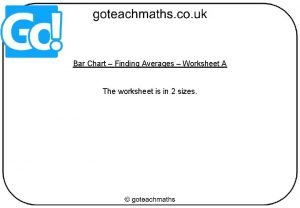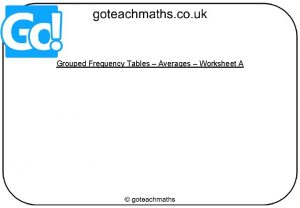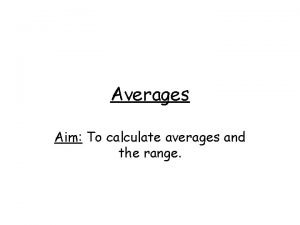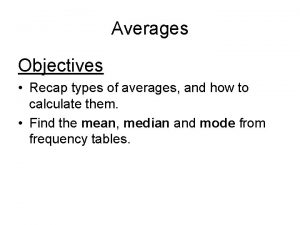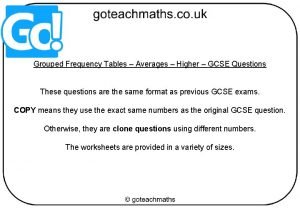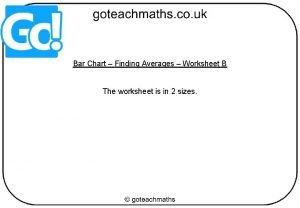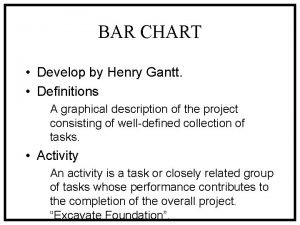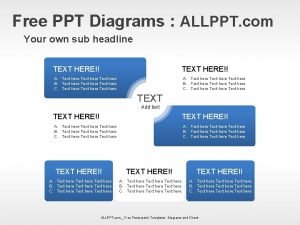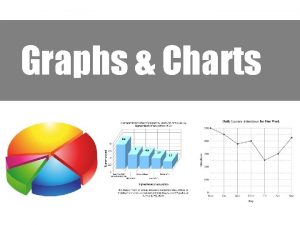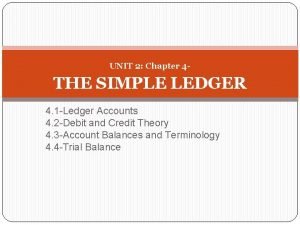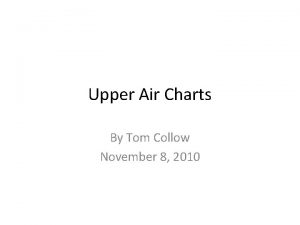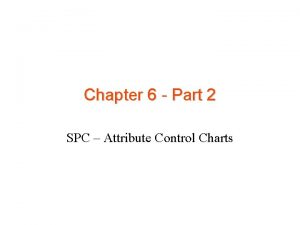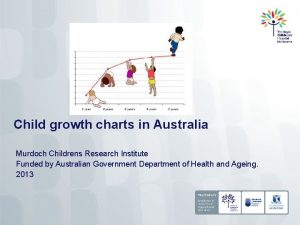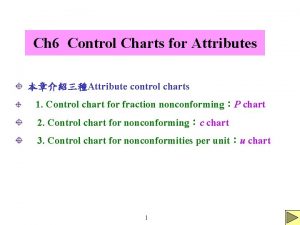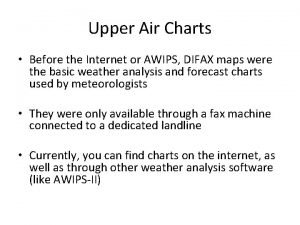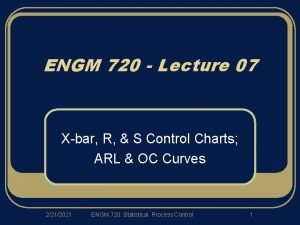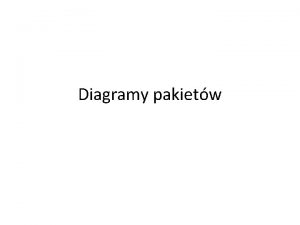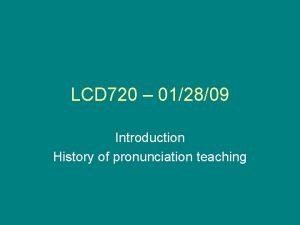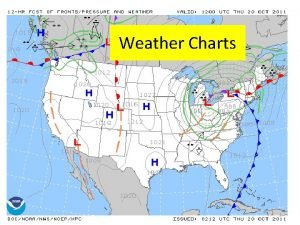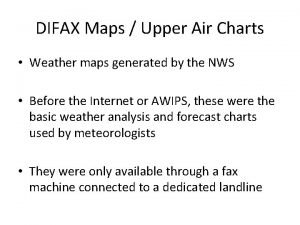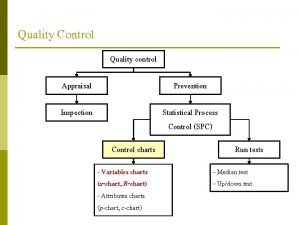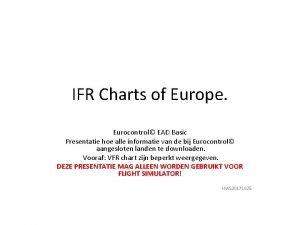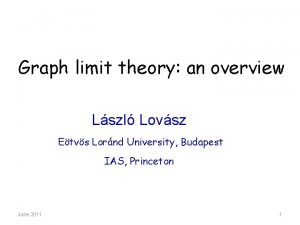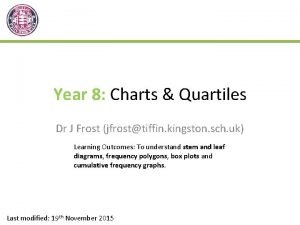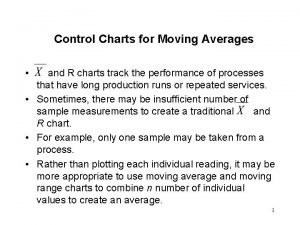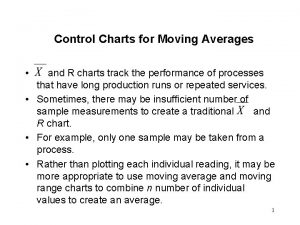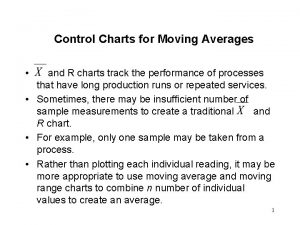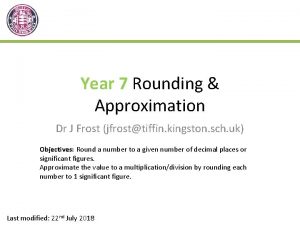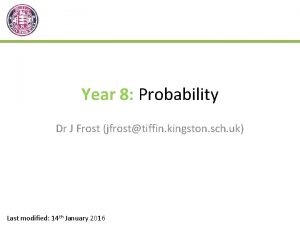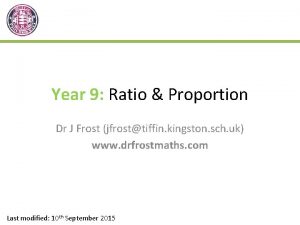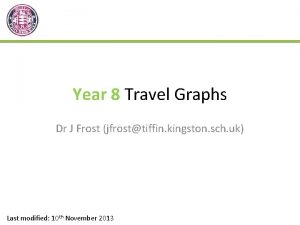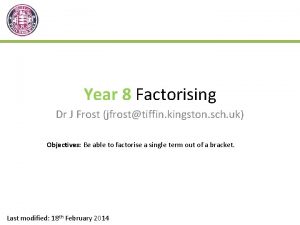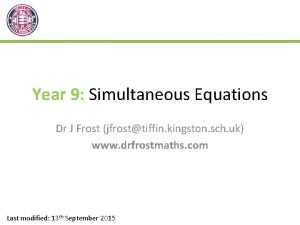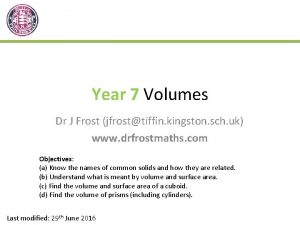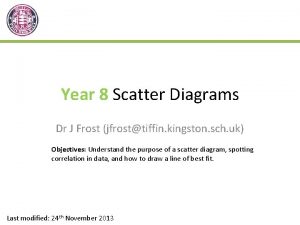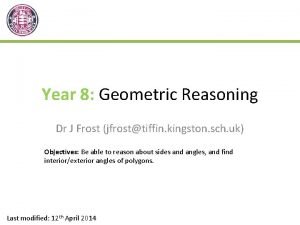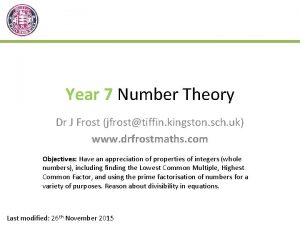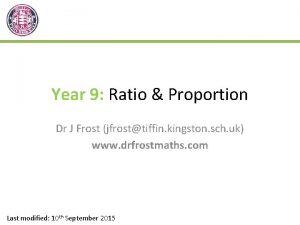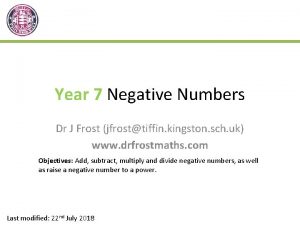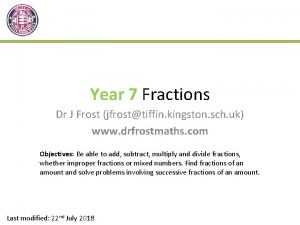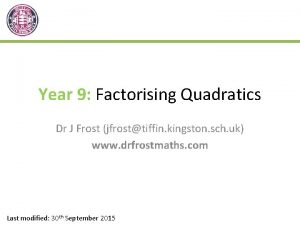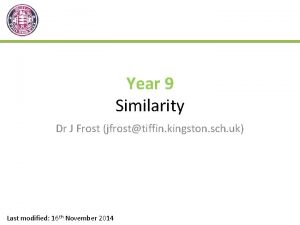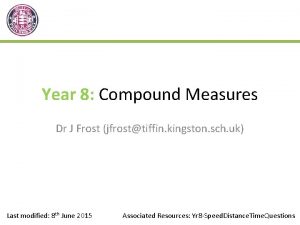Year 7 Charts Averages Dr J Frost jfrosttiffin





























![Test Your Understanding [JMC 2003 Q 9] The mean age of the four members Test Your Understanding [JMC 2003 Q 9] The mean age of the four members](https://slidetodoc.com/presentation_image_h/7f48e794a98be29940fc465f25b87a91/image-30.jpg)


















- Slides: 48

Year 7: Charts & Averages Dr J Frost (jfrost@tiffin. kingston. sch. uk) Last modified: 18 th March 2016

For Teacher Use: Recommended lesson structure: Lesson 1: Introduction. Pie charts. Lesson 2: Frequency Diagrams (Bar Charts vs Histograms, Frequency Polygons) Lesson 3: Averages (from listed data) and range. Lesson 4: Stem and Leaf Lesson 5: Mean of frequency table/Estimated mean of grouped data. Combined means. Go > Go >

Ways of Displaying Data In pairs, try and think of all the different types of ‘charts’ and diagrams you could use to display data. Frequency Diagrams Pie charts (Covered in KS 2, Year 7) Frequency Polygons Bar charts (Covered in Year 7, 8) (Covered in KS 2) Histogram (Covered at GCSE) Stem & Leaf Diagrams (Covered in Year 7, 8) Pictogram (Covered in KS 2) Cumulative Frequency Graphs (Covered in Year 8) Box Plot (Covered in Year 8)

Year 7 Pie Charts Dr J Frost (jfrost@tiffin. kingston. sch. uk)

Pie Charts For which sets of data is a pie chart suitable, and which are not (and why? ) If not, suggest a better way to display this data. Goals so far this season by top 4 teams Pie charts should be used when we interested in proportions/percentage/fractions of some total and are less concerned with the frequencies. The fraction of the total goals of the four teams is not particularly significant here, it’s the number of goals (i. e. the frequencies) we’re more interested in. A more suitable representation would be a bar chart: Goals so far this season by top 4 teams ? 50 45 40 35 30 25 20 Chelsea Arsenal QPR The Bickerstaffs 15 10 5 0 Chelsea Arsenal QPR The Bickerstaffs

Pie Charts For which sets of data is a pie chart suitable, and which are not (and why? ) If not, suggest a better way to display this data. Hours Dr Frost spends doing this activity on a typical day Year 7's Favourite Colour 10% 17% 25% 42% 6% Sleep Travel Eat PS 4 Work Giving Detentions Yes this is suitable. We’re interested in what proportion of a day Dr Frost is doing different things. ? Bro Tip: Don’t use a pie if either: (a) There’s not a clear total for which we can have fractions of. (b) The pie chart wouldn’t work if we were to omit the frequencies. Red Blue Green Taupe Other Yes this is suitable. We’re interested in what proportion of Year 7 who like each of the colours. The percentages here are more ? important than the frequencies.

To work out frequencies from the angles, simply see what fraction of a full circle the slice occupies. Favourite Colour Frequency Fraction Favourite Colour Angle Red 20 ? ? Green 60 ? ? Blue 120 ? ? TOTAL 200 Best Event Frequency Fraction Angle Heptathlon 40 ? ? Pentathlon 17 ? ? Icosathlon 63 ? ? TOTAL 120 Red Green Blue It’s exactly the same principle the other way round.

Favourite Colour Frequency Red 50 Green 75 TOTAL ? Angle ? Even if the total isn’t available, we can find missing angles/frequencies by: a) Finding out what one person/degree is worth or b) Scaling. e. g. If the angle doubles, the frequency doubles, and so on.

Test Your Understanding Instrument Frequency Fraction Violin 18 ? ? Piano 33 ? ? Trumpet 69 ? ? TOTAL 120 Angle

How to draw a super awesome pie chart Title Key Circle drawn with compass and lines drawn with ruler. ? ?

Variants of pie charts Sectors labelled with percentages.

Variants of pie charts Sectors labelled with percentages and values. No key.

Calculating percentages and angles Squirrel Type Frequency Percentage Angle Red 49 30% 108° Grey 87 Black 23 Ferret (not a squirrel) 4 TOTAL 163 ? 53% ? 14% ? 3% ? 100% ? ? 191° 50° 11° ? ? ?

Exercise 1 1 (on provided sheet) 2 We’ll do the first one together. . . Favourite Colour Frequency Fraction Angle Red Games Console Owned Frequency Fraction Angle Wii U Blue PS 3 ? ? Green Orange Favourite Colour ? (Pie chart using protractor and ruler) Red Blue Green Orange ? ? ? ? Xbox 360 None Games Console Owned ? (Pie chart using protractor and ruler) Wii U PS 3 Xbox 360 None ? ?

Exercise 1 (on provided sheet) 4 3 Holiday Destination Frequency Fraction Angle ? ? Europe Asia Africa Antarctica ? ? Student continent of Origin ? (Pie chart using protractor and ruler) Europe Asia Africa Age of mother 16 -30 Frequency Fraction ? ? 30 -35 35 -40 40+ Angle ? ? Age of mother ? (Pie chart using protractor and ruler) Antarctica 16 -30 30 -35 35 -40 40+

Year 7 Frequency Diagrams Dr J Frost (jfrost@tiffin. kingston. sch. uk)

Frequency Diagrams When we record data, we may record the number of times we saw a value (we’d use a ‘tally’ when collecting the data) – this is known as the frequency. A frequency table might show ungrouped or grouped data: Grouped Data Ungrouped Data Shoe Size Frequency 12 ½ 4 9 13 10 1402 13 ½ 6 1 frequency A Frequency Diagram are charts where the vertical axis shows the frequency.

Types of Frequency Diagrams BAR CHART HISTOGRAM Frequency 20 15 10 5 0 0 1 2 3 Num People Driving Car 4 ! Features: • For discrete data. Values written on ? horizontal axis. • Gaps between bars (why? to emphasise values are discrete) ? • Can have multiple sets of data. Bro Note: Not all bar charts are frequency diagrams, e. g. if the vertical axis was “sales (£)” Frequency (Density) 25 0 10 20 30 40 50 Height (m) ! Features: • For grouped continuous data. • No gaps between bars (because data is continuous) • Allows bars to be different widths.

Frequency Polygons But suppose that we had data grouped into ranges. What would be a sensible value to represent each range? IQ (x) Frequency 2 16 15 8 0 4 We use the midpoint of each range. This is known as a frequency polygon. Join the points up with straight lines. 14 Frequency ! Sometimes we see frequency polygons combined with a histogram (why is not called a bar chart? ). The points of the frequency polygon will be in the middle of the bars. 12 10 8 6 4 2 90 100 110 120 130 140 IQ

Exercise 2 (on provided sheet) Q 1 Q 2 ? ?

Exercise 2 Q 3 (on provided sheet) Pick the most suitable chart to display the data described. (Put as appropriate) Data I’m taking a survey to establish people’s favourite brand of bread. I give a number of shoppers a taste of each and then record their favourite. Pie Chart? Bar chart? Histogram/ Frequency Polygon? The frequencies depend on how many people are surveyed so are not important. We care more what proportion of people like each brand. ? is continuous. Weight I want to show votes for 5 different candidates for 7 AJW Form Captain. I record the shoe size of 100 children. I group them into intervals, e. g. 1 ½ -3, 3 ½ 5, 5 ½ -7, … I survey 500 university students who have just graduated to see what type of career they’ve gone into (Education, Finance, …) ? We care about the number of votes for each. But a pie chart would also be suitable. ? ? is continuous. Length Shoe size is discrete. Bar charts are better for grouped numerical data. ? ?

Exercise 2 Q 4 (on provided sheet) a) Draw a bar chart for this frequency table using the axis provided. Ensure you label your axes. Age 11 -15 16 -20 21 -25 26 -30 Freq 3 6 2 7 b) Why technically are we using a bar chart and not a histogram? While time is continuous, the age ranges are written here in a way that suggests that age is discrete (i. e. it’s ? rounded to a whole). If we did allow decimal ages, what group would 15. 6 go in? There would be gaps! 8 6 ? 4 2 11 -15 16 -20 21 -25 26 -30

Year 7 Averages and Range Dr J Frost (jfrost@tiffin. kingston. sch. uk)

Averages There are different averages: some are more meaningful than others depending on the context. What is the average number of ears in the world human population? The mode (the “modal average”) The median The mean ? The mode represents the most common value. Modal number of ears: 2? The median represents the middle value. ? Median number of ears: 2 ? The mean takes into account all values. We add up the values and divide by the number of values. ? Mean number of ears: 0. 99999

Averages The mode (the “modal average”) The median The mean The mode tends to be a good average when the values are discrete and have a limited range of values. e. g. “red red green blue” (the mode is ‘red’) Median is often good because it makes it easier to tell whether a value is in the top 50% or the bottom 50%. It’s also less sensitive to extreme values. The mean is the best average to use if we want to take all the values into account. Salaries of people in the room: £ 13, 000 £ 18, 000 £ 24, 000 £ 25, 500 £ 26, 000 £ 32, 000 £ 45, 000 £ 1, 200, 000 What would the best average be here? Median, because the £ 1, 200, 000 salary drags up the mean. Otherwise all but one person would earn less than the average! ?

Averages Copy these numbers down, and work out the mean, mode and median. 10, 13, 15, 16, 17, 20 The mode 17? The median 16? (the “modal average”) The mean 10 + 13 + 15 + 16 + 17 + 20 ? = 15. 43 7

Averages – Round 2! Copy these numbers down, and work out the mean, mode and median. 13, 17, 20 The mode 13? The median ? 15 (the “modal average”) The mean The range When there’s two items in the middle, we use the value in between: i. e. add them and divide by 2. ? 15. 75 7? The range is the difference between the smallest and largest number. The range is NOT an average.

Puzzles involving mean In pairs, see how many of these puzzles you can work out… 1 The mean average of Dr Frost and Sebastian’s age is 19. 5. If Sebastian is 13, how old is Dr Frost? 3 ? Answer: 12 and 18 Answer: 26? 2 The mean of the four numbers is 8. What is the missing number? 3 4 5 Answer: 20 ? If the range of two numbers is 6 and their mean is 15, what are the two numbers? 4 The mode of four numbers is 5. The median is 6. 5 and the mean is 7. What is the range? ? Answer: 5 ? (The numbers are 5, 5, 8, 10)

Using totals A class with 30 students gets an average mark of 60%. An extra student joins and the average mark rose to 61%. What mark did he get? ?
![Test Your Understanding JMC 2003 Q 9 The mean age of the four members Test Your Understanding [JMC 2003 Q 9] The mean age of the four members](https://slidetodoc.com/presentation_image_h/7f48e794a98be29940fc465f25b87a91/image-30.jpg)
Test Your Understanding [JMC 2003 Q 9] The mean age of the four members of ‘All Sinners’ boy band is 19. What is the mean age when an extra member who is 24 years old joins them? A 19 B 20 C 21 D 22 E 24 A B C D E [JMC 2010 Q 20] Nicky has to choose 7 different positive whole numbers whose mean is 7. What is the largest possible such number she could choose? A 7 B 28 C 34 D 43 E 49 A B C D E

Exercise 3 For the following lists of numbers, determine the following: 1 2 3 4 (on provided sheet) Mode Median Mean Range 1, 2, 3, 4, 5 1, 3, 3, 6, 10, 13 -4, -2, 6, 6 None 3 6 None 3 4. 5 2 0. 5 4 12 10 1 -1. 8, 0, 2. 7, 4. 9, 14. 9 3. 8 ? 3 ? 6 ? 1. 5 ? 0. 5 ? 5. 12 5 6 ? ? 16. 7 Determine the numbers given the clues. a. Two numbers have a mean of 9 and a range of 6. Solution: 6, 12 b. The mode of four numbers is 6, the median is 8, and the mean is 9. Solution: 6, 6, 10, 14 c. The median of four numbers is 6, the range is 5 and the mode is 4. Solution: 4, 4, 8, 9 ? ? ? [JMC 2013 Q 2] Heidi is 2. 1 m tall, while Lola is only 1. 4 m tall. What is their average height? Solution: 1. 75 m [JMC 2007 Q 12] The six-member squad for the Ladybirds five-a-side team consists of a 2 -spot ladybird, a 10 -spot, a 14 -spot, an 18 -spot, a 24 -spot and a pine ladybird (on the bench). The average number of spots for members of the squad is 12. How many spots has the pine ladybird? S: 4 7 ? 8 9 ? ?

Exercise 3 10 (on provided sheet) N 1 ? 11 ? [JMO Mentoring Feb 2012 Q 5] On the second to last test of the school year, Barbara scored 98 and her average score so far then increased by 1. On the last test she scored 70 at which her average score then decreased by 2. How many tests has she taken through the school year? ? Solution: 10 12 ? 13 ? 14 ? N 2 [Cayley 2007 Q 6] You are told that one of the integers in a list of distinct positive integers is 97 and that their average value is 47. (a) If the sum of all the integers in the list is 329, what is the largest possible value for a number in the list? (b) Suppose the sum of all the numbers in the list can take any value. What would the largest possible number in the list be then? ? Solution: (a) 217 (b) 1078

Year 7 Stem and Leaf Diagrams Dr J Frost (jfrost@tiffin. kingston. sch. uk)

Stem and Leaf Diagram Suppose this “stem and leaf diagram” represents the lengths of beetles. 1 2 3 4 5 4 1 2 4 5 2 5 6 6 6 7 7 8 8 0 1 2 2 4 5 6 7 7 8 0 1 1 2 Value represented = 4. 5 cm ? These numbers (known as the ‘stems’) represent the first digit of the number. The key tells us how two digits combine. Key: 2 | 1 means 2. 1 cm The ‘leaves’ must be in order. These numbers (the ‘leaves’) represent the second.

Example Here are the weights of a group of cats. Draw a stem-and-leaf diagram to represent this data. 36 kg 15 kg 35 kg 50 kg 11 kg 36 kg 38 kg 47 kg 12 kg 30 kg 18 kg 57 kg 1 1 2 5 8 ? ? 2 ? 3 0 5 6 6 8 ? 4 7 ? 5 0 7 ? Key: 3 | 8 means 38 kg ? What do you think are the advantages of displaying data in a stem-and-leaf diagram? • Shows how the data is spread out. • Identifies gaps in the values. ? • All the original data is preserved (i. e. we don’t ‘summarise’ in any way).

Your turn Here is the brain diameter of a number of members of 8 IW. Draw a stem and leaf diagram representing this data. 1. 3 cm 2. 1 cm 5. 3 cm 2. 0 cm 1. 7 cm 4. 2 cm 3. 3 cm 3. 2 cm 1. 3 cm 4. 6 cm 1. 9 cm 1 3 3 7 9 ? 2 0 1 ? 3 2 3 ? 4 2 6 ? 5 3 ? ? ? ? Key: 3 | 8 means 3. 8 cm ?

Exercise 3 1 (on provided sheet) Here are the times, in minutes, taken to solve a puzzle. 5 10 15 12 8 7 20 35 24 15 20 33 15 24 10 8 10 20 16 10 (a) In the space below, draw a stem and leaf diagram to show these times. 0 5 7 8 8? 1 0 0 2 5 5 5 6 ? 2 0 0 0 4 4 ? 3 3 5 ? (b) Find the median time to solve this puzzle. 15 minutes ? Key: 3|4 means ? 34 minutes

Exercise 3 2 The stem and leaf diagram gives information about the numbers of tomatoes on 31 tomato plants. Work out the median. 32 tomatoes ? (on provided sheet)

Exercise 3 3 (on provided sheet) Here are the ages, in years, of 15 students. 19 18 20 25 37 33 21 17 29 20 42 18 23 37 22 Show this information in an ordered stem and leaf diagram. 1 7 8 8 9 ? 2 ? 0 0 1 2 3 5 9 3 3 7 7 ? 4 2 ? 1|3 means 13 years ?

Exercise 3 4 (on provided sheet) Here is the weight of 16 cats: 4. 5 kg 5. 0 kg 7. 4 kg 4. 9 kg 3. 6 kg 5. 2 kg 4. 9 kg 5. 3 kg 3. 8 kg 4. 1 kg 4. 3 kg 5. 3 kg (a) Produce an ordered stem and leaf diagram to show this information. 3 6 6 8 9? 4 1 3 5 9 9 ? 5 0 2 3 3 3 ? ? 6 7 Key: 3|6 means 3. 6 kg ? 4 ? (b) What is the median weight? 4. 9 kg ? (c) What is the mode weight? 5. 3 kg ?

Year 7 Mean of Frequency Tables Dr J Frost (jfrost@tiffin. kingston. sch. uk)

Mean of Frequency Tables We know how to find the mean of listed data. What if we have a frequency table? Age of Dog Frequency 10 3 11 4 12 7 13 6 14 1 TOTAL 21 ? 44 ? 84 ? 78 ? 14 ? 250 ? 30 Starting point: Suppose we listed this data out with duplicated values. What would be the total age of the dogs aged 10? Once we’d found the total, we’d usually divide by the number of values. What is that? 21. A common mistake is to divide by 5 because there’s 5 rows. But that’s the number of unique values, and doesn’t take into account duplicates. There’s 21 dogs, not 5! ? ?

Test Your Understanding Cost Frequency £ 1. 50 1 £ 1. 65 20 £ 1. 70 21 £ 1. 80 5 £ 2. 00 2 Weight Frequency 2 kg 4 3 kg 0 4 kg 8 5 kg 7 6 kg 3 ? ?

Mean of Grouped Data A number of members of 8 EWS are running in a race. Their times were as follows We don’t know the individual times within each group. What time could we use for each person in the 35 -40 group? 37. 5 ? Why is it an estimate? Time (secs) Freq 225 ? 37. 5 540 ? 45 60 TOTAL 27? 540 ? 1305 ? ? Because we don’t know the exact times within each group. ?

Test Your Understanding Age of rock (years) Frequency ? ?

Combining Means We can use a similar approach when combining means. Class 7 SM, with 30 students, got an average of 60 marks in a maths test. Class 7 XQ, with 25 students, got an average of 75 marks in the same maths test. What was the average mark across all students? ?

Exercise 5 (on provided sheet) 1 4 ? Weight Frequency 2 3 Value Frequency 6 cm 3 16 -20 kg 3 ? 20 -30 kg 4 30 kg-32 kg 1 5 ? Height (nearest cm) Frequency 10 -16 kg 7 7 cm 8 ? 8 cm 12 9 cm 4 £ 0 -£ 1000 10 £ 1 000 -5 000 25 10 cm 1 £ 5 000 -£ 20 000 6 ? 6 Time (minutes) Frequency 35 -40 5 40 -42 15 ? 42 -48 20 48 -60 10 £ 20 000 -£ 100 000 1

Exercise 5 7 (on provided sheet) 9 ? 8 ? ?
 Dr frost frequency tables
Dr frost frequency tables Prefix averages
Prefix averages Mean grouped frequency table
Mean grouped frequency table Moving averages gcse
Moving averages gcse Prefix averages
Prefix averages Median frequency table
Median frequency table Averages worksheet
Averages worksheet Averages from frequency tables worksheet
Averages from frequency tables worksheet How to find mean median and mode in frequency table
How to find mean median and mode in frequency table Types of averages
Types of averages Frequency tables gcse
Frequency tables gcse Averages worksheet
Averages worksheet Year 6 leaving poems
Year 6 leaving poems Vtsp charts
Vtsp charts Bar diagram advantages and disadvantages
Bar diagram advantages and disadvantages Osdi charts
Osdi charts Noaa enc charts
Noaa enc charts Allppt free template
Allppt free template Charts 1977 international
Charts 1977 international Gantt and pert charts
Gantt and pert charts Class charts goffs churchgate
Class charts goffs churchgate Allppt.com _ free powerpoint templates
Allppt.com _ free powerpoint templates Notice and note anchor charts
Notice and note anchor charts Charts and tables
Charts and tables Diagram klas
Diagram klas Vertical line charts gcse
Vertical line charts gcse Cross over charts
Cross over charts Allppt.com _ free powerpoint templates, diagrams and charts
Allppt.com _ free powerpoint templates, diagrams and charts The simple ledger chapter 4
The simple ledger chapter 4 Constant pressure charts
Constant pressure charts P chart spc
P chart spc World health organization growth charts
World health organization growth charts Percentile charts australia
Percentile charts australia Bar charts gcse questions
Bar charts gcse questions 3 sigma limits
3 sigma limits Lclk charts
Lclk charts Upper air 850, 700, 500 & 300 mb charts
Upper air 850, 700, 500 & 300 mb charts Engm charts
Engm charts Package diagram
Package diagram Fidel charts
Fidel charts Insulin onset, peak duration chart
Insulin onset, peak duration chart Low level prognostic chart
Low level prognostic chart Upper air charts
Upper air charts Attribute control charts
Attribute control charts 20%ของ300
20%ของ300 Ead basic
Ead basic Lszl charts
Lszl charts Line balance chart
Line balance chart Acfi behaviours
Acfi behaviours
